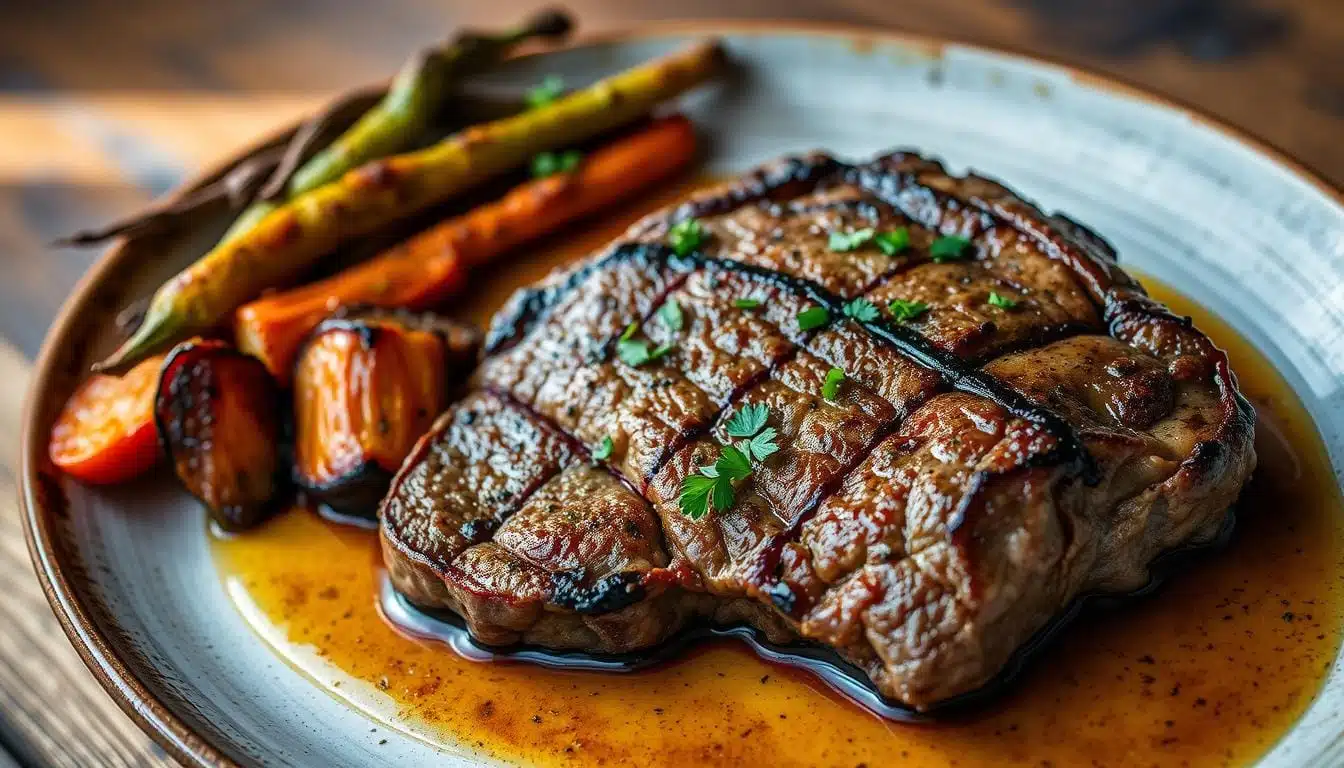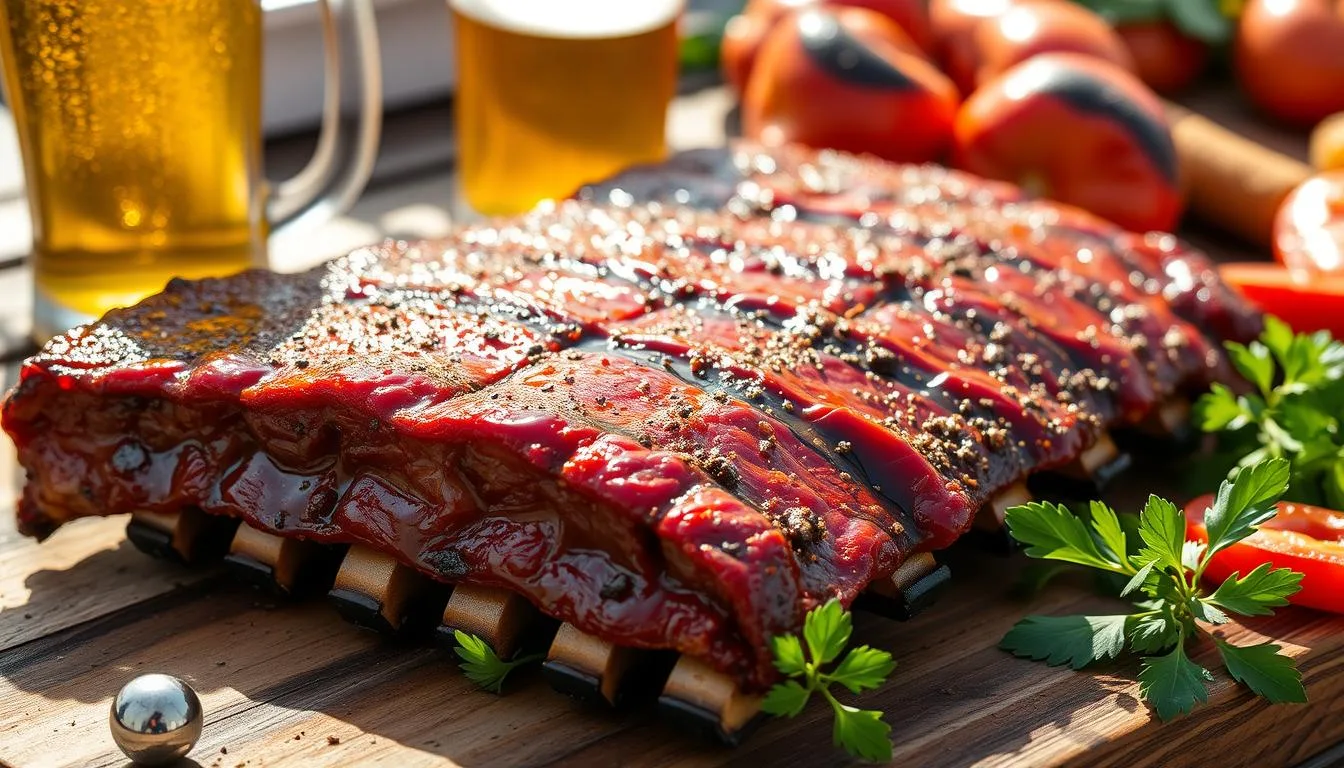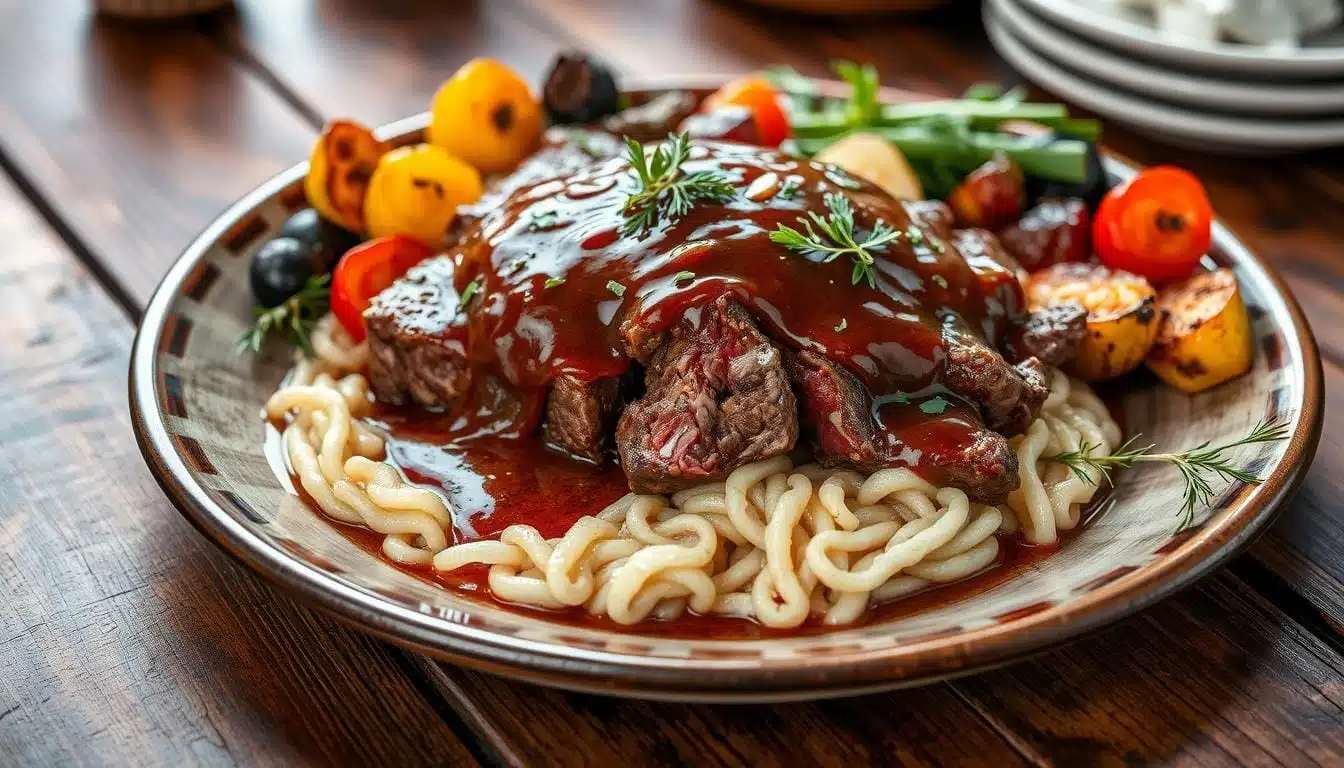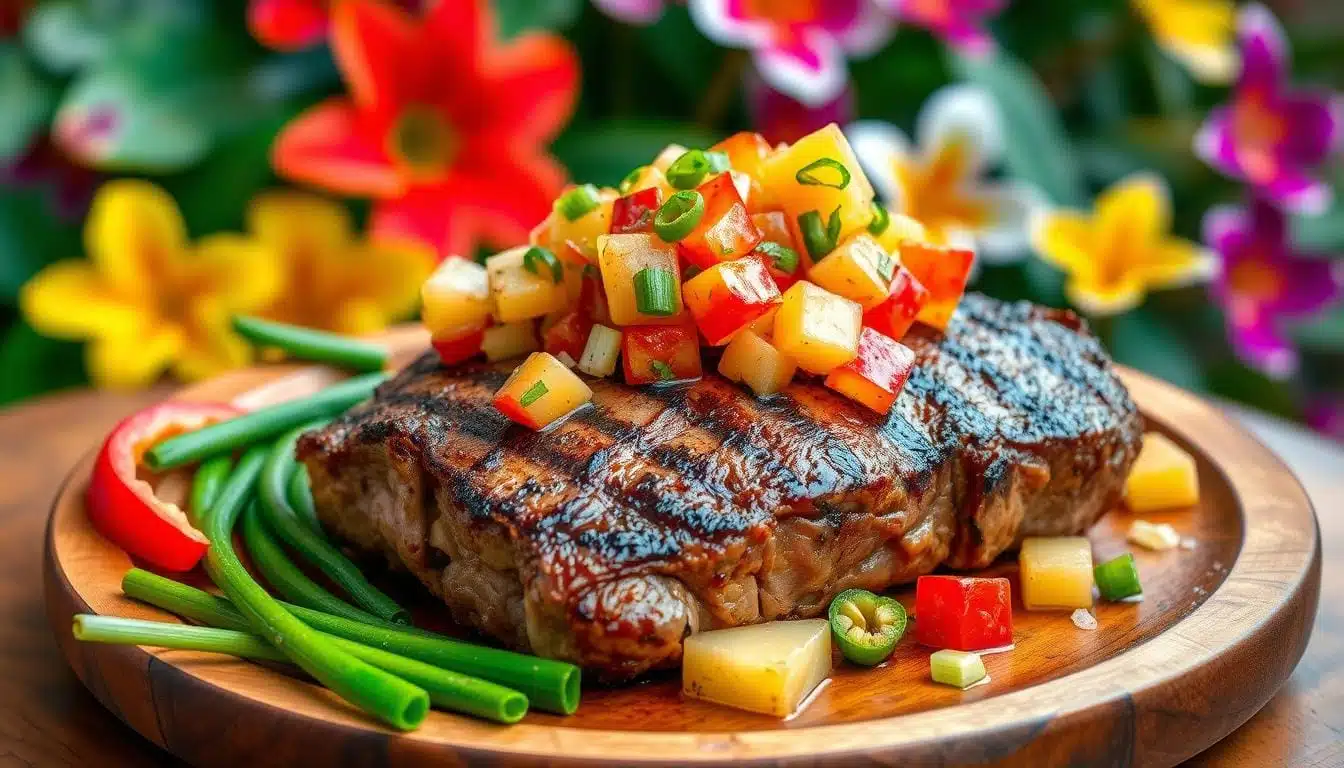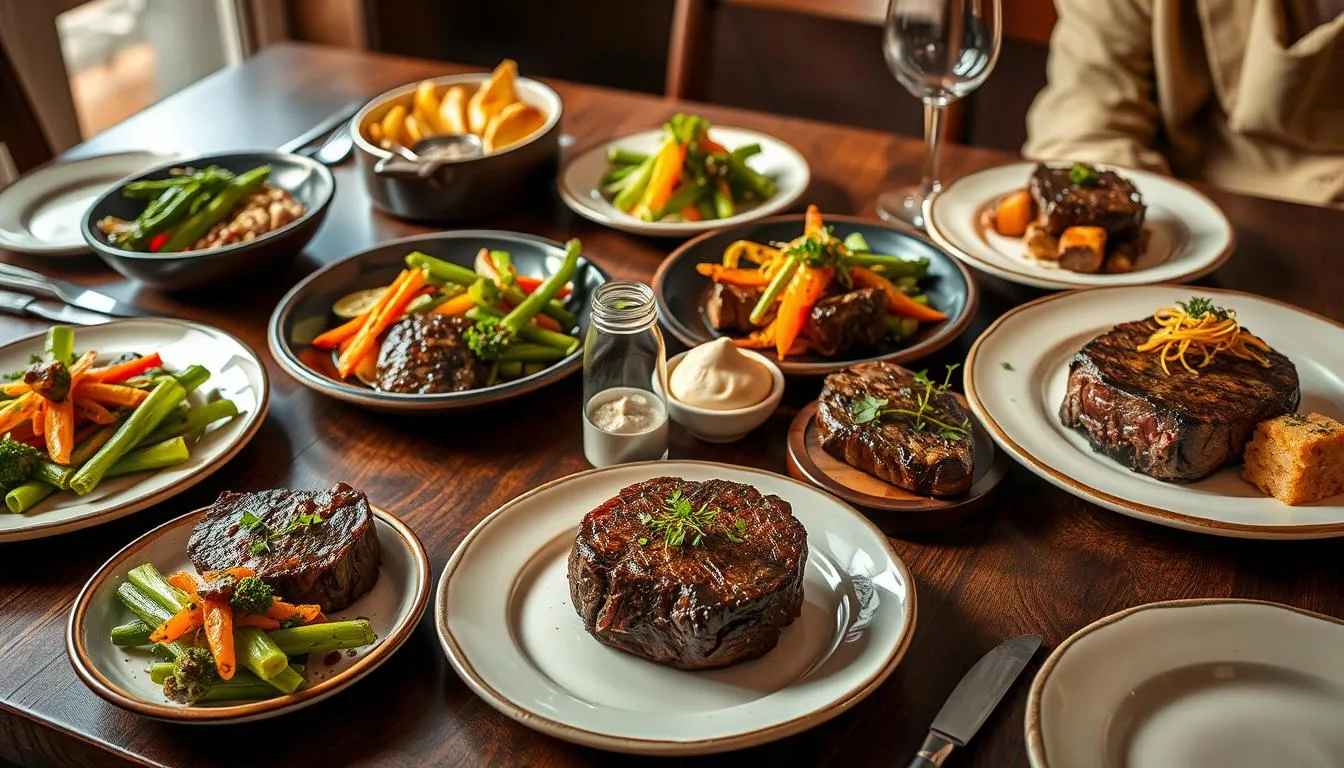Ultimate Steak Cooking Chart: Perfect Every Time
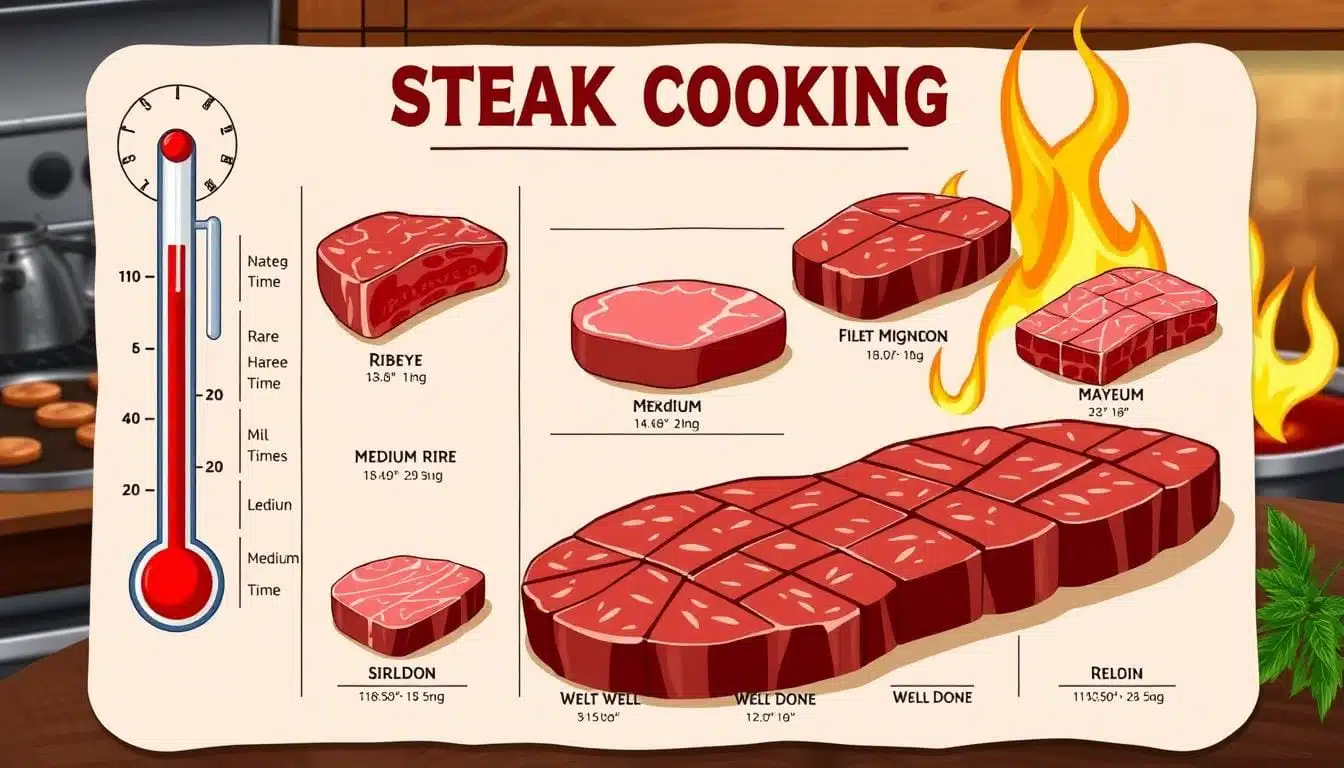
Ever wondered how to get the perfect steak every time? Whether you like it medium rare, medium, or well-done, knowing how to cook it right is key. Our ultimate steak cook levels will help you find the perfect medium rare steak temp. Say goodbye to overcooked meat.
Getting the meat just right is important for taste and safety. The USDA says beef should be cooked to 80-160°F (26.7 – 71.1°C) for taste. But for safety, cook it to 145°F (62.8°C) and rest it for 3 minutes.
In this guide, we’ll cover steak doneness levels from rare to well-done. You’ll get a handy chart for different meats. We’ll also share tips on using a digital meat thermometer and grilling techniques. This way, your steaks will always be perfect.
Table of Contents
Understanding Steak Doneness Levels
Cooking the perfect steak means knowing the different doneness levels. Each level affects the steak’s texture, flavor, and juiciness. Here’s a guide to the various levels and their temperature ranges.
Rare Steak: 120° to 125°
A rare steak is cool in the center and very juicy. It should be between 120°F and 125°F. Remove it from heat at 115°F and rest for 5 minutes to reach the perfect medium rare steak temp.
Medium Rare Steak: 130° to 135°
Medium rare steaks have a warm center and a bit firmer texture. Aim for 130°F to 135°F. Remove it at 125°F and rest for a few minutes to get the perfect medium rare steak temp.
Medium Steak: 140° to 145°
A medium steak has a warm, pink center and a firmer texture. For medium doneness, aim for 140°F to 145°F. Remove it at 135°F and rest while you set the table, allowing it to reach the ideal medium steak temperature.
Medium Well Steak: 150° to 155°
Medium well steaks have a slightly pink center and a firm texture. The internal temperature should be between 150°F and 155°F. Remove it at 145°F and rest for 5-10 minutes to avoid dryness.
Well-Done Steak: 160° to 165°
A well-done steak has little to no pink in the center and is very firm. It should be between 160°F and 165°F. Remove it at 155°F and rest for a few minutes to avoid overcooking and dryness.
| Steak Doneness | Temperature Range | Description | Estimated Cook Time |
|---|---|---|---|
| Rare | 125°F – 130°F | Red center, cool temperature, extremely juicy | 8 minutes |
| Medium Rare | 130°F – 135°F | Warm, red center with dark pink edges, soft texture | 9 minutes |
| Medium | 135°F – 140°F | Light pink, warm center | 10 minutes |
| Medium Well | 140°F – 150°F | Hot center with slightly pink hue, little to no color on edges | 11 minutes |
| Well Done | 155°F or above | No pink in the center | 12 minutes or more |
Knowing the different steak doneness levels and their temperatures lets you cook your steak perfectly. Whether you like it rare, medium, or well-done, you can achieve it every time.
The Importance of Internal Temperature
Grilling the perfect steak means getting the doneness just right. Whether you like it rare, medium rare, or well-done, the secret is in the internal temperature. Use a steak cooking chart and know the ideal medium rare steak temp to cook it perfectly every time.
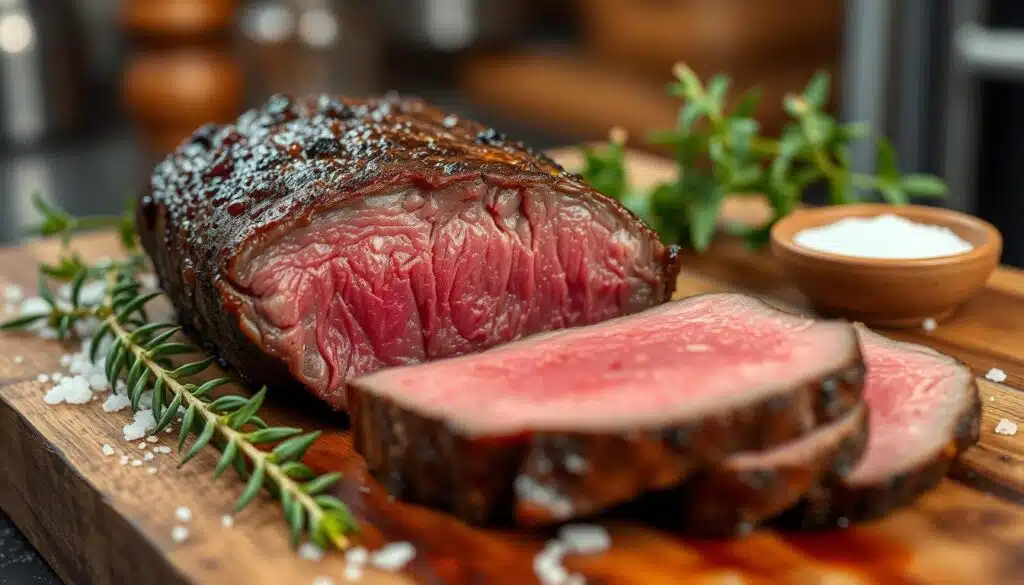
The internal temperature tells you when a steak is done. It doesn’t matter if it’s a thick cut or cooked on a hot grill. Each doneness level has a specific temperature. For example, a medium rare steak should be between 130°F and 135°F (54°C to 57°C).
To get the right doneness, take the steak off the grill when it’s about five degrees shy of the target. This is because the steak will keep cooking a bit after it’s off the grill. This is called carryover cooking. The meat’s temperature can go up by about 5°F (3°C) during this time.
Monitoring the internal temperature of your steak is the most reliable way to ensure that it is cooked to your desired level of doneness.
Here are some important temperature guidelines for grilling different meats:
- Poultry: Cook to an internal temperature of 165°F (75°C).
- Ground beef: Cook to an internal temperature of 160°F (70°C).
- Steak and veal: Cook to at least 145°F (65°C).
- Lamb chops and mutton: Cook to at least 145°F (65°C), with ground lamb requiring 160°F (70°C).
- Pork and ham: Cook to 145°F (65°C), while reheated precooked ham or pork products should reach 165°F (75°C).
By following these guidelines and using a steak cooking chart, you can cook steaks to the perfect doneness every time. The key is to check the internal temperature and let the meat rest before serving.
Using a Digital Meat Thermometer
A digital meat thermometer makes it easy to get the perfect steak. It gives you accurate temperature readings. This means your steak will always be cooked just right.
When using a digital thermometer, keep a few things in mind. This will help you get the best results.
Finding the Thickest Part of the Steak
To get the right temperature, put the thermometer in the thickest part of the steak. This is usually the center. It’s the coolest spot and gives the most accurate reading.
Don’t put the probe near the edges or thin parts. These cook faster and can give wrong readings.
Inserting the Thermometer Probe
When you insert the probe, angle it slightly. This helps it reach the center without touching bone, fat, or gristle. These can mess up the reading.
Push the probe through until it comes out the other side or hits bone. Then, slowly pull it back to find the lowest temperature.
- Quick & Easy Longhorn Steak Seasoning Recipe
- Succulent Delmonico Steak Recipe – Grill Perfection
- Savory Steak and Beans and Onions Recipe: The Perfect Meal
- The Ultimate Hawaiian Chopped Steak Recipe: A Taste of Island Comfort
- The Best Grilled Chopped Steak Recipe You’ll Ever Try
Reading the Temperature Accurately
Wait for the reading to stabilize before taking the steak out. The perfect medium rare steak is between 130°F and 135°F (54°C to 57°C).
Here’s a quick guide to steak doneness levels and their temperatures:
| Doneness Level | Temperature Range |
|---|---|
| Rare | 120°F to 125°F (49°C to 52°C) |
| Medium Rare | 130°F to 135°F (54°C to 57°C) |
| Medium | 140°F to 145°F (60°C to 63°C) |
| Medium Well | 150°F to 155°F (66°C to 68°C) |
| Well Done | 160°F to 165°F (71°C to 74°C) |
By using a digital meat thermometer and following these tips, you can grill steaks to your liking. This ensures a delicious meal every time.
Factors Affecting Cooking Time
When using a steak cooking chart, consider several factors that affect cooking time. The type of steak, its thickness, and the grill’s heat are key. These elements determine how long your steak will cook.
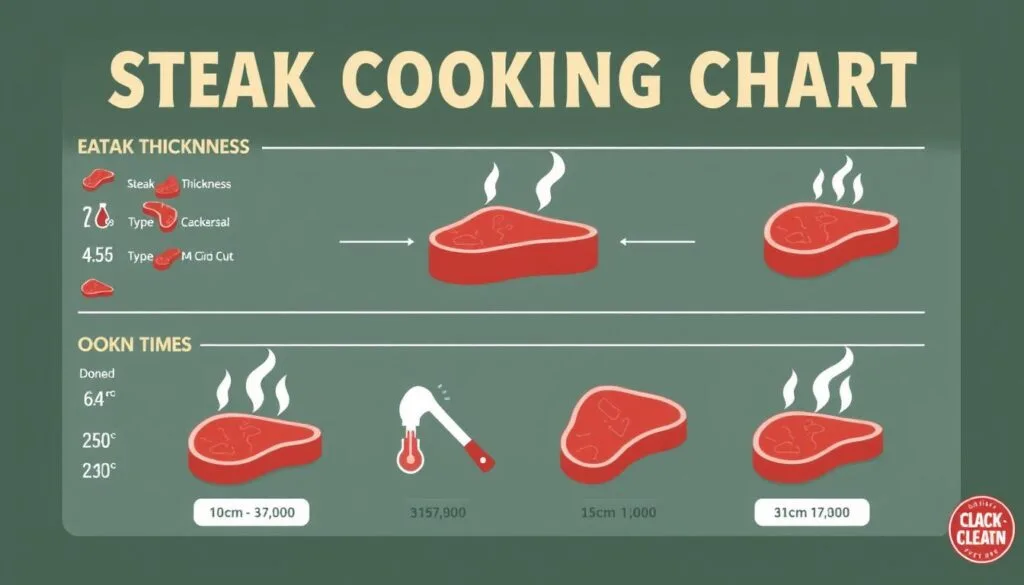
Type of Steak
Different steaks vary in tenderness, marbling, and fat content. This affects cooking time. For instance, a lean top sirloin cooks faster than a fatty ribeye. Here’s a list of steak cuts and their cooking times:
| Steak Cut | Rare | Medium Rare | Medium | Medium Well |
|---|---|---|---|---|
| Ribeye | 4-5 min/side | 5-6 min/side | 6-7 min/side | 7-8 min/side |
| NY Strip | 4-5 min/side | 5-6 min/side | 7-8 min/side | 8-9 min/side |
| Top Sirloin | 4 min/side | 7-8 min/side | 9-10 min/side | 11-12 min/side |
| Filet Mignon | 4-5 min/side | 5-6 min/side | 6-7 min/side | 7-8 min/side |
Thickness of the Steak
Steak thickness is crucial for cooking time. Thicker steaks need more time to cook than thinner ones. Aim for 4-5 minutes per side for each inch of thickness at high heat.
A 1 1/2-inch thick porterhouse will require different cooking times compared to a thin flank steak.
Heat of the Grill
The grill’s temperature also affects cooking times. A hotter grill sears faster, needing less time to cook. A cooler grill takes longer. Always check the recommended grill temperature on your chart and adjust as needed.
By considering steak type, thickness, and grill heat, you can perfect your cooking times. Use a meat thermometer to ensure food safety and achieve your desired doneness.
Preparing the Steak for Grilling
Before you start grilling, make sure your steak is ready. Letting it come to room temperature and seasoning it well are key. These steps help you achieve a perfectly grilled rare steak or any doneness you prefer.
Bringing the Steak to Room Temperature
Letting your steak warm up to room temperature is crucial. It ensures even cooking and a juicy center. Remove the steak from the fridge and let it sit for 30-45 minutes before grilling.
Allowing a steak to come to room temperature before grilling is a game-changer. It results in a more evenly cooked steak with a juicy, tender interior and a perfectly seared exterior.
Seasoning the Steak
After your steak warms up, it’s time to season it. Some like to keep it simple with salt and pepper. Others like to try different blends to bring out the meat’s flavor. Here are some seasoning tips:
- Pat the steak dry with paper towels to remove excess moisture. This helps the seasoning stick better.
- Use plenty of salt and freshly ground black pepper on both sides. Press the seasoning into the meat.
- If using a blend, spread it evenly over the steak’s surface.
- Season just before grilling to avoid losing moisture.
By warming up your steak and seasoning it well, you’re on your way to a perfectly grilled steak. Now, it’s time to grill it to perfection.
Grilling Techniques for Perfect Steaks
To get a perfectly grilled steak, especially a medium rare one, you need to know a few tricks. Follow these grilling tips to make a steak that’s juicy, full of flavor, and cooked just right.
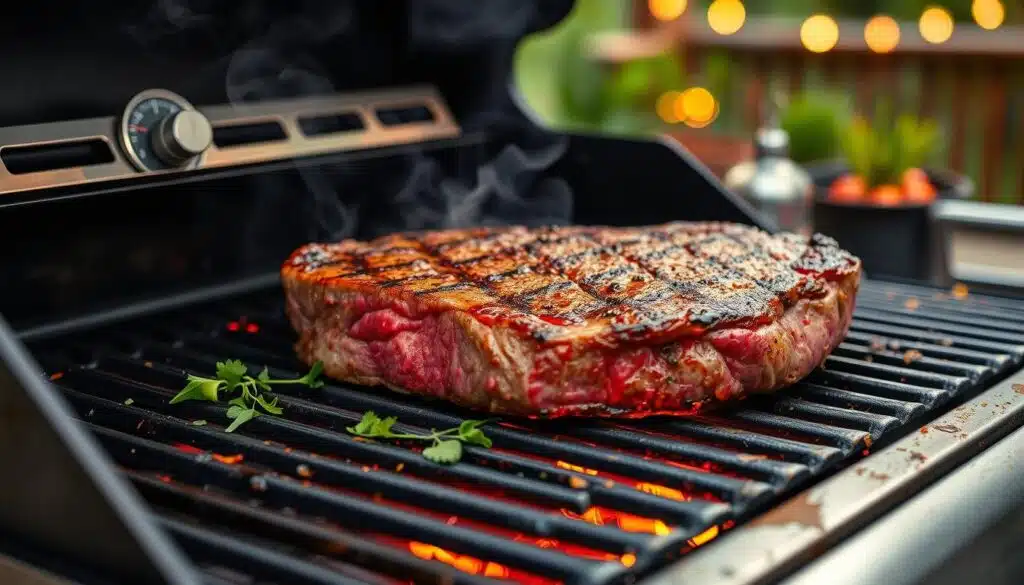
Preheating the Grill
Before grilling your steak, make sure the grates are hot. A hot grill is key for a great sear and a tasty crust on your steak. Heat your gas or charcoal grill to 450-500°F for the best results.
Searing the Steak
When your grill is ready, it’s time to sear your steak. Place the steak on the grates and let it cook for 2-3 minutes without moving. This high heat will give your steak a flavorful crust, sealing in the juices and making it taste better. For a medium rare steak, aim for an internal temperature of 130-135°F.
Flipping and Rotating the Steak
After searing one side, flip the steak over and keep cooking. To cook evenly, rotate the steak 45 degrees on each side. This will also help you avoid hot spots on your grill. For a 1-inch thick steak, cook for about 4-5 minutes per side to get it just right.
| Steak Thickness | Rare (120-130°F) | Medium Rare (130-135°F) | Medium (135-140°F) |
|---|---|---|---|
| 1 inch (Filet mignon, Strip steak) | 3-4 minutes per side | 4-5 minutes per side | 5-6 minutes per side |
| 1 ¼ inch (Ribeye, Sirloin) | 4-5 minutes per side | 5-6 minutes per side | 6-7 minutes per side |
Mastering these grilling techniques and watching cooking times and temperatures will help you make the perfect steak. Remember, the more you practice, the better you’ll get. So, don’t be afraid to try new things and adjust your methods as you go.
Steak Cooking Chart
Learning to cook steak to perfection is all about knowing the right temperatures and cooking times. This detailed chart helps you cook beef, veal, pork, lamb, and ground meat just right. It ensures your steaks are always a hit with family and friends.
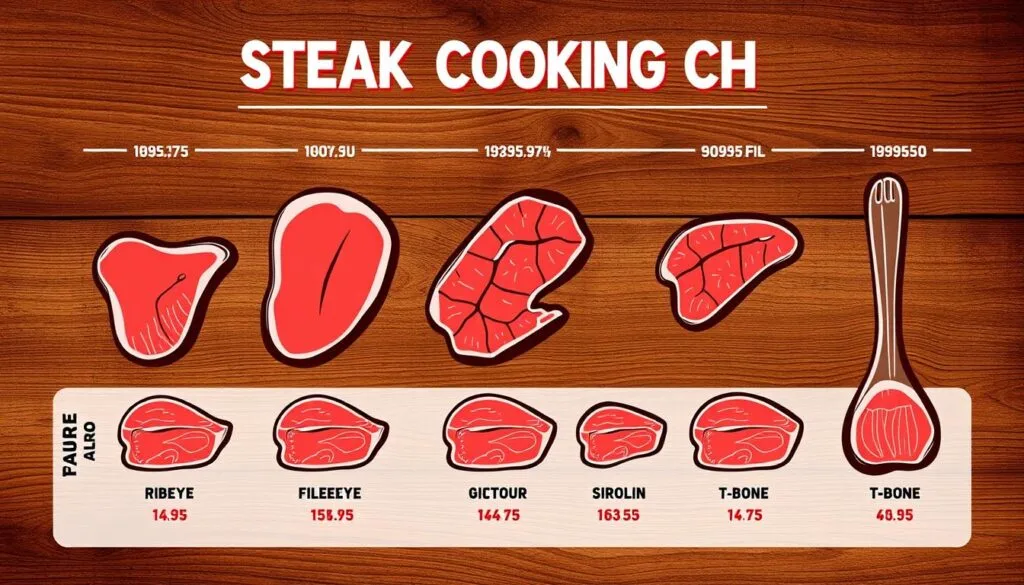
Beef (Steaks & Roasts)
For beef steaks and roasts, the goal is to hit the perfect internal temperature. Here’s a guide for each doneness level:
- Extra Rare or Blue: 80-100°F
- Rare: 120-125°F
- Medium Rare: 130-135°F
- Medium: 140-145°F
- Medium Well: 150-155°F
- Well: 160°F and above
For a 1-inch thick steak, here are the cooking times for each level:
| Doneness | Cooking Time (per side) |
|---|---|
| Rare | 5 then 3 minutes |
| Medium-Rare | 5 then 4 minutes |
| Medium | 6 then 4 minutes |
| Medium-Well | 7 then 5 minutes |
| Well-Done | 12 then 10 minutes |
Veal (Shanks, Chops & Roasts)
Veal is a delicate meat that needs careful cooking to keep it tender and flavorful. Here are the recommended internal temperatures:
- Rare: 135°F
- Medium Rare: 145°F
- Medium: 160°F
- Well: 170°F and above
Pork (Chops & Roasts)
The USDA says pork should be cooked to 145°F for a light pink center. This ensures the pork is safe and juicy.
Lamb (Shanks, Chops, Roasts & Legs)
Lamb can be cooked to different doneness levels. Here are the recommended internal temperatures:
- Rare: 135°F
- Medium Rare: 140-150°F
- Medium: 160°F
- Well: 165°F and above
Ground Meat
Ground meat, like beef, pork, or lamb, must be cooked thoroughly for safety. The FDA suggests cooking it to 160°F or above. This makes it uniformly grey or brown.
By following this steak cooking chart and using a reliable digital meat thermometer, you can confidently grill or cook your favorite cuts of meat to the perfect doneness level every time.
Resting the Steak
After grilling your steak, it’s important to let it rest before cutting. This step helps the juices spread evenly, making the steak juicier and more flavorful. For a perfect medium rare, remove the steak when it hits 125°F (52°C) and rest for 5-10 minutes.
While resting, the steak’s internal temperature will slightly increase. This is why you should remove it a few degrees before your target. For instance, aim for 130-135°F (54-57°C) and take it off the grill at 125°F (52°C).
| Doneness | Remove from Heat | Final Temperature | Resting Time |
|---|---|---|---|
| Rare | 115°F (46°C) | 120-125°F (49-52°C) | 5-10 minutes |
| Medium Rare | 125°F (52°C) | 130-135°F (54-57°C) | 5-10 minutes |
| Medium | 135°F (57°C) | 140-145°F (60-63°C) | 5-10 minutes |
| Medium Well | 145°F (63°C) | 150-160°F (65-71°C) | 5-10 minutes |
| Well Done | 155°F (68°C) | 160-170°F (71-77°C) | 5-10 minutes |
Don’t cut into your steak right after cooking. Cutting too soon lets the juices spill out, making the steak dry and less tasty. Letting it rest ensures a juicy, flavorful steak that highlights the beef’s natural taste.
Patience is key when it comes to achieving the perfect medium rare temp. Take the time to let your steak rest, and you’ll be amazed by the difference it makes in both texture and taste.
Carryover Cooking and Steak Temperature
When grilling steak, it’s key to know about carryover cooking. Carryover cooking is when the steak keeps cooking after it’s off the grill. This happens because of the heat still in the meat.
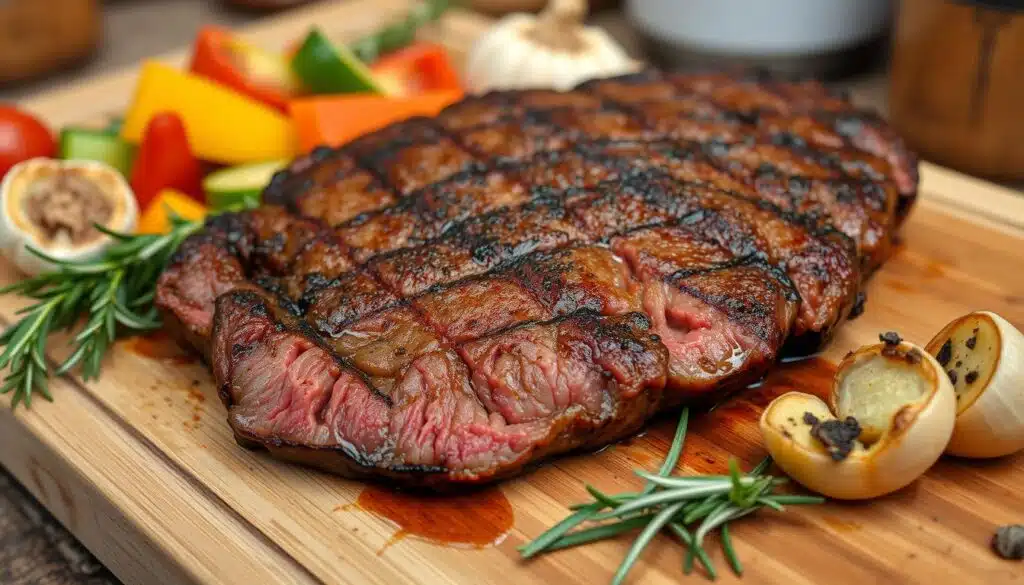
To get the right doneness, remove the steak when it’s 5°F (3°C) lower than your goal. For a medium rare, aim for 125-130°F (52-54°C) before taking it off. As it rests, the heat will cook it more, reaching the perfect medium rare.
Many things affect how much carryover cooking happens. The steak’s thickness, the grill’s temperature, and its shape all play a part. Thicker steaks and those cooked at higher temperatures will cook more after being removed.
| Steak Cut | Thickness | Cooking Time per Side (Medium Rare) |
|---|---|---|
| Ribeye (boneless) | 1 inch | 2-3 minutes |
| Ribeye (bone-in) | 1.5 inches | 4.5-5.5 minutes |
| New York Strip | 1 inch | 4.5-5.5 minutes |
| Filet Mignon | 1.5 inches | 3-4 minutes |
| Porterhouse (T-Bone) | 1.5 inches | 4.5-5.5 minutes |
Using a meat thermometer is crucial for accurate results. Stick it into the thickest part of the steak, avoiding bones or fat. When it hits the right temperature, take it off the grill and let it rest for 5-10 minutes. This makes the steak tender and juicy.
Understanding carryover cooking and using a thermometer helps you get the perfect steak. Adjust cooking times and temperatures based on the steak’s thickness and cut for the best results.
Common Mistakes to Avoid
Grilling the perfect steak can be tricky. Knowing common mistakes helps avoid a bad meal. Two big errors are overcooking and cutting into the steak too soon.
Overcooking the Steak
Overcooking steak makes it dry and tough. To avoid this, use a meat thermometer. The ideal temperature for a medium-rare steak is between 130°F and 135°F (54°C to 57°C).
Remember, the steak’s temperature will rise a bit after it’s off the grill. So, take it off when it’s about 5°F lower than your desired doneness.
Cutting into the Steak Too Soon
Cutting into the steak too soon can also ruin it. It needs time to rest and let juices spread evenly. Cutting too soon means less flavor and a drier steak.
Let your steak rest for 5 minutes for thinner cuts and up to 15 minutes for thicker ones. This step is key for the perfect texture and taste, as shown in the rare steak temp guidelines.
| Common Mistake | How to Avoid |
|---|---|
| Overcooking the steak | Use a meat thermometer and refer to the steak cooking chart for ideal internal temperatures |
| Cutting into the steak too soon | Allow the steak to rest for 5-15 minutes, depending on thickness, as per the rare steak temp guidelines |
By avoiding these mistakes, you’ll grill perfect steaks every time. Use a meat thermometer, check the steak cooking chart, and let the steak rest before cutting. This way, you’ll get a juicy, flavorful steak that will wow everyone.
Tips for Grilling the Perfect Steak
Grilling the perfect steak needs technique, timing, and temperature control. To get the best results, follow these key tips. They help you master the art of steak grilling, whether you want a juicy medium rare or a well-done steak.
First, bring your steak to room temperature before grilling. This ensures even cooking, avoiding a cold center and overcooked edges. Just take the steak out of the fridge 30 minutes before grilling.
Next, heat your grill to the right temperature for your steak’s doneness. For medium rare, aim for 450°F to 500°F. For well-done, heat it a bit higher. A hot grill is essential for a nice sear and a juicy inside.
A meat thermometer is a griller’s best friend when it comes to ensuring accurate internal temperatures.
To ensure your steak is perfectly cooked, use a reliable meat thermometer. It helps you check the meat’s internal temperature. Here are the temperature ranges for different doneness levels:
- Rare: 120°F to 130°F
- Medium Rare: 130°F to 135°F
- Medium: 135°F to 140°F
- Medium Well: 140°F to 150°F
- Well Done: 150°F to 160°F
Once your steak hits the right temperature, take it off the grill. Let it rest for at least five minutes before cutting. This step makes the steak more flavorful and tender. Don’t cut into it right away, as it will lose juices and become dry.
While grilling, flip and rotate the steak to cook evenly. But don’t flip it too often. This can mess up the sear and cooking. Aim to flip it only once or twice during cooking.
| Steak Cut | Thickness | Rare | Medium Rare | Medium |
|---|---|---|---|---|
| Ribeye | 1 inch | 3-4 minutes per side | 4-5 minutes per side | 5-6 minutes per side |
| Sirloin | 1 inch | 3-4 minutes per side | 4-5 minutes per side | 5-6 minutes per side |
| Filet Mignon | 2 inches | 4-5 minutes per side | 5-6 minutes per side | 6-7 minutes per side |
| New York Strip | 1 inch | 3-4 minutes per side | 4-5 minutes per side | 5-6 minutes per side |
By following these tips and using a steak cooking chart, you’ll grill perfect steaks every time. Remember, practice makes perfect. Don’t worry if your first try isn’t perfect. With patience and attention to detail, you’ll impress everyone with your steak-grilling skills.
Pairing Steak with Side Dishes
Choosing the right side dishes can make your medium rare steak dinner even better. You can pick from colorful veggies, comforting potatoes, or refreshing salads. Each option brings out the rich flavors of your steak.
Vegetables
Vegetables add color, texture, and nutrients to your steak meal. Here are some great veggie sides for your steak:
- Grilled asparagus with olive oil and sea salt
- Roasted Brussels sprouts with bacon and balsamic glaze
- Sautéed mushrooms with garlic and herbs
- Charred bell peppers and onions for a smoky taste
- Oven-roasted carrots with honey and thyme
Potatoes
Potatoes are a classic steak side, adding comfort to your meal. Try these potato dishes:
- Creamy mashed potatoes with butter and chives
- Crispy roasted potatoes with rosemary and garlic
- Loaded baked potatoes with sour cream, bacon, and cheese
- Potato wedges or steak fries for a rustic feel
- Scalloped potatoes with cream and Parmesan
Salads
A fresh salad can cut the richness of your steak. Here are some salad ideas:
- Classic Caesar salad with romaine, Parmesan, and croutons
- Caprese salad with tomatoes, mozzarella, and basil
- Spinach salad with strawberries, feta, and pecans
- Arugula salad with Parmesan, lemon vinaigrette, and pine nuts
- Wedge salad with iceberg lettuce, blue cheese, and bacon
Finding the right balance between your steak and sides is key. Mix and match veggies, potatoes, and salads to make a complete meal. This way, your medium rare steak will be the star of the show.
| Side Dish Category | Popular Options | Percentage of Recipes |
|---|---|---|
| Vegetables | Grilled asparagus, roasted Brussels sprouts, sautéed mushrooms | 35% |
| Potatoes | Mashed potatoes, roasted potatoes, loaded baked potatoes | 40% |
| Salads | Caesar salad, Caprese salad, spinach salad | 25% |
By picking the right side dishes, you can make your steak dinner unforgettable. Impress your guests and satisfy your cravings with a perfectly balanced meal.
Steak Cooking Methods Beyond Grilling
Grilling is a favorite way to cook steak, but there are other methods too. Pan-searing, oven-roasting, and sous vide cooking are gaining fans. Each method has its own benefits and can help you get the perfect doneness.
Pan-Searing
Pan-searing uses a skillet heated high on the stovetop. It cooks the steak quickly on both sides. This method makes a tasty crust and keeps the inside juicy.
To get a medium rare steak, cook it for 2 minutes on each side. Then, move the skillet to a 350°F oven for 2 to 5 minutes. Let the steak rest for 5-7 minutes before you serve it.
Oven-Roasting
Oven-roasting, or the reverse sear, cooks the steak slowly in a low oven. Then, it’s seared hot in a skillet. This method ensures even cooking and a consistent temperature.
For a medium-rare steak, preheat the oven to 200°F. Cook the steak for 20 to 35 minutes until it’s 135°F inside. Sear it in a hot skillet for 1-2 minutes on each side. Let it rest for 7-10 minutes before serving.
Sous Vide Cooking
Sous vide cooking seals the steak in a bag and cooks it in a water bath. It’s precise and ensures even cooking. This method guarantees a perfect medium rare steak every time.
To cook a steak sous vide, set the water bath to 130°F. Cook the steak for 1 to 4 hours, depending on its thickness. After cooking, sear the steak in a hot skillet for 30-60 seconds on each side.
| Cooking Method | Tenderness Rank | Char Development Rank |
|---|---|---|
| Sous Vide | 1st | 6th |
| Stovetop-to-Broiler | 3rd | 2nd |
| Stovetop-to-Oven | 4th (tied) | 3rd |
| Stovetop Only | 6th | 5th |
In a study comparing various steak cooking methods, sous vide cooking produced the most tender steak, while the stovetop-to-broiler method ranked second in char development.
Try different cooking techniques and check the steak’s internal temperature. You’ll find the perfect method for your favorite dish.
Choosing the Right Cut of Steak
Choosing the right steak is key to grilling the perfect one. Different cuts vary in tenderness, flavor, and marbling. This makes some better for grilling than others.
Filet mignon is great for those who want a tender steak. It’s known for its delicate taste and fine marbling. Ribeye steaks, on the other hand, are rich in flavor due to their fat content. They’re perfect for those who love flavor more than tenderness.
New York strip steaks offer a good balance of tenderness and flavor. They’re less expensive than filet mignon and ribeye, making them great for everyday meals. Sirloin steaks, in 7 or 12 ounce sizes, are also affordable and pack a punch in flavor when cooked right.
| Cut | Thickness | Characteristics |
|---|---|---|
| Filet Mignon | 2-3 inches | Tender, delicate flavor, fine marbling |
| Ribeye | ¾-1 ½ inches | Rich, beefy flavor, generous marbling |
| New York Strip | 1-2 inches | Tender, versatile, balanced flavor |
| Sirloin | 1-2 inches | Affordable, good flavor when cooked properly |
T-bone and porterhouse steaks are great for those who love bone-in steaks. They offer both tenderloin and New York strip flavors. But, they can be hard to cook evenly to the perfect medium rare.
The best steak cut is a matter of personal taste. It depends on what you value most: tenderness, flavor, price, or the occasion.
When picking a steak, think about its thickness. Steaks 1 to 1 ½ inches thick are best for grilling. They get a nice sear on the outside and stay juicy inside. Thinner cuts like flank or skirt steak are better for quick cooking methods like stir-frying.
Conclusion
Learning to cook steak to your liking is easy once you know the basics. It’s all about the internal temperature and using a steak cooking chart. A good meat thermometer is key to getting the temperature right. This ensures your steak is cooked just the way you want it.
For instance, a medium rare steak should be between 130°F and 135°F. A rare steak is best at 120°F to 125°F. By following this guide, you can make steaks that wow your loved ones.
Whether you like your steak juicy and tender or firmer, this guide has you covered. As you get better at cooking steak, try new cuts, seasonings, and cooking methods. This will help you find new favorites.
The secret to a great steak is knowing how temperature and doneness go together. Use a meat thermometer and the chart to cook steaks perfectly every time. With a bit of practice, you’ll be a pro at grilling, pan-searing, or oven-roasting steaks. Your guests will be impressed, and you’ll enjoy every delicious bite.
